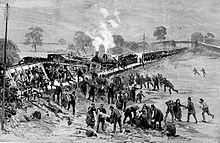Hexthorpe railway accident
The railway accident Hexthorpe was a rear-end collision , located in the breakpoint of Hexthorpe on a stretch of the South Yorkshire Railway km west 2.5 of Doncaster occurred on 16 September 1887th 25 people died.
Starting position
The breakpoint Hexthorpe did not own signals , trains were of two adjacent block locations covered.
Doncaster hosts a horse race every September , the week-long St. Leger Festival. To cope with the traffic rush with many special features, was considered during the festival a special regulation: Trains from the West of England held in the breakpoint Hexthorpe where the tickets were checked. In addition, more than one train was let into the occupied block section and this traffic was regulated by two security posts between the entrance signal for the block section and Hexthorpe with flag signals.
the accident
At the time of the accident, there were three trains in the block section : the first had already left Hexthorpe, a second of the Midland Railway was on the platform and the third was an express train from Liverpool to Hull of the Manchester, Sheffield and Lincolnshire Railway . The engine driver of the express train was a stranger on this route of the South Yorkshire Railway and was not informed about the special operational situation.
Both the distant signal and the main signal for the relevant block section initially showed "stop" as the train slowly approached. When the main signal was switched to "free travel", the engine driver erroneously assumed that the whole block was now free and accelerated his train. The first track keeper he passed did not react at all, the second gave an ambiguous signal so that the engine driver continued to pick up speed. Due to a curve, he only saw the stopping train 200 m before the impact. He was only able to brake his train from about 55 km / h to about 30 km / h before the collision occurred.
On impact, the main line tore, the Smith brake became ineffective and the waiting passenger train was hit by the no longer braking, inertial mass of the express train. All victims were people who had been in the wrecked carriages of the Midland Railway passenger train.
consequences
25 people died, 94 were also injured.
Judicial processing
Criminal proceedings were opened against the train crew before the Lord Chief Justice of England and Wales and a jury in York . It was the first in which the union for locomotive crews ( - Associated Society of Locomotive Engineers and Firemen ASLEF participated and renowned legal representation for the accused locomotive engineer and) heater set. The jury came to the verdict “not guilty”. The defendants were thus acquitted. The Lord Chief Justice massively criticized the railway company for the use of the then technically outdated Smith brake. Criticism was also raised because of the operating regulations applied and the lack of instruction of the staff.
Technical consequences
The investigation by the railway supervisory authority identified insufficiently trained personnel in a particular operational situation and the outdated braking system of the approaching train as the main causes. Together with the Armagh railway accident that soon followed, the accident accelerated the elimination of simple vacuum brakes .
Worth knowing
The employees of the Manchester, Sheffield and Lincolnshire Railway offered to help compensate for the damage by foregoing a daily income. This was rejected by the management because the employees were dependent on the money themselves.
See also
literature
- George Dow: Great Central . Vol. 2, 1962.
- Oswald Stevens Nock : Historic Railway Disasters . 3rd ed. London 1983, pp. 15-19. ISBN 0-7110-0109-X .
- Lionel Thomas Caswell Rolt : Red for Danger . Edition: London 1978. ISBN 0-330-25555-X
Web links
Individual evidence
- ^ Rolt, p. 85.
Coordinates: 53 ° 30 ′ 40.9 " N , 1 ° 9 ′ 15.2" W.
